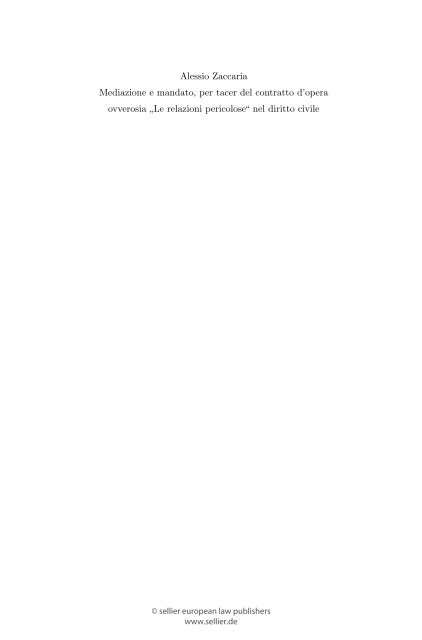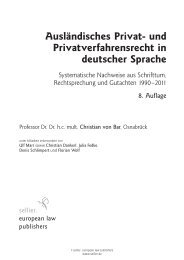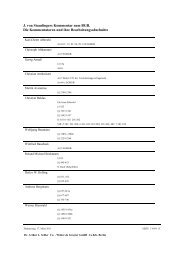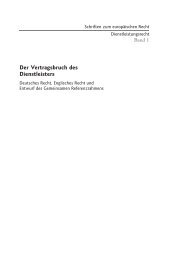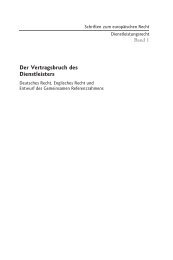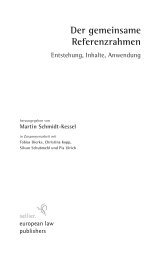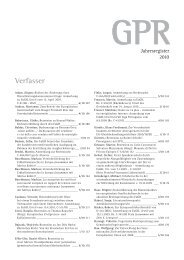Mediazione e mandato, per tacer del contratto d'opera ... - Sellier
Mediazione e mandato, per tacer del contratto d'opera ... - Sellier
Mediazione e mandato, per tacer del contratto d'opera ... - Sellier
Create successful ePaper yourself
Turn your PDF publications into a flip-book with our unique Google optimized e-Paper software.
Alessio Zaccaria<br />
<strong>Mediazione</strong> e <strong>mandato</strong>, <strong>per</strong> <strong>tacer</strong> <strong>del</strong> <strong>contratto</strong> d’o<strong>per</strong>a<br />
ovverosia ” Le relazioni <strong>per</strong>icolose“ nel diritto civile<br />
© sellier european law publishers<br />
www.sellier.de
Studien zum Europäischen Privatrecht und zur Rechtsvergleichung<br />
Band 4<br />
Herausgegeben von den Professoren<br />
Dr. Robert Freitag, Dr. Martin Gebauer, Dr. Wolfgang Hau,<br />
Dr. Matthias Lehmann, Dr. Stefan Leible, Dr. Dirk Looschelders,<br />
Dr. Peter Mankowski, Dr. Martin Schmidt-Kessel, Dr. Götz Schulze,<br />
Dr. Dennis Solomon, Dr. Ansgar Staudinger, Dr. Hannes Unberath<br />
© sellier european law publishers<br />
www.sellier.de
<strong>Mediazione</strong> e <strong>mandato</strong>,<br />
<strong>per</strong> <strong>tacer</strong> <strong>del</strong> <strong>contratto</strong> d’o<strong>per</strong>a<br />
ovverosia ” Le relazioni <strong>per</strong>icolose“ nel diritto civile<br />
von<br />
Alessio Zaccaria<br />
JWV<br />
Jenaer Wissenschaftliche Verlagsgesellschaft 2011<br />
© sellier european law publishers<br />
www.sellier.de
Bibliographische Information der Deutschen Nationalbibliothek<br />
Die Deutsche Nationalbibliothek verzeichnet diese Publikation in der<br />
deutschen Nationalbibliographie; detaillierte bibliographische Daten sind<br />
im Internet über abrufbar.<br />
Alle Rechte vorbehalten<br />
�2011 JWV Jenaer Wissenschaftliche Verlagsgesellschaft mbH<br />
Druck: Bookstation GmbH, Sipplingen<br />
Satz: Societas Verlag (www.societas-verlag.de)<br />
Printed in Germany<br />
ISBN 978-3-86653-214-4<br />
Gedruckt auf alterungsbeständigem (säurefreiem)<br />
Papier entsprechend ISO 9706<br />
Internet: www.jwv.de<br />
© sellier european law publishers<br />
www.sellier.de
A Beatrice Aleida,<br />
oggi dolcemente furiosa <strong>per</strong> il tempo sottrattole,<br />
domani, forse, ancor più furiosa,<br />
e non più dolcemente,<br />
quando, se accadrà, qui leggendo,<br />
potrà, <strong>del</strong> furto, capir la ragione.<br />
Ma chissà,<br />
forse anche così,<br />
rincorrendo<br />
ugualmente ostinata,<br />
anziché una palla o un balón, queste righe,<br />
mi porterai con Te,<br />
nei Tuoi pensieri,<br />
Amore mio:<br />
“pàpa cè. . . ”.<br />
Regensburg, Osnabrück, Ferrara, 2010 - 2011<br />
© sellier european law publishers<br />
www.sellier.de
© sellier european law publishers<br />
www.sellier.de
Vorwort<br />
Questo scritto ha tratto spunto da una sentenza <strong>del</strong>la Corte italiana di<br />
Cassazione (la n. 16382 <strong>del</strong> 14 luglio 2009) con la quale i Giudici <strong>del</strong> Supremo<br />
Collegio hanno, in sostanza, sostenuto che la mediazione si risolverebbe<br />
(non in un <strong>contratto</strong>, bensì) in un “‘contatto sociale’ mutante”, potendo il<br />
suo “genoma” trasformarsi (a seguito <strong>del</strong>l’assunzione <strong>del</strong>l’obbligo di agire)<br />
in quello proprio <strong>del</strong> <strong>mandato</strong>. Si tratta di affermazioni nate, evidentemente,<br />
grazie a una buona dose di fantasia; tanto che non mi è sembrato fuori<br />
luogo concludere un altro mio scritto in tema augurando a tutti i Peter Pan<br />
<strong>del</strong> diritto un felice viaggio verso l’“Isola che non c’è” * .<br />
All’inizio, l’idea era quella di stendere una nota a sentenza. Ma il lavoro<br />
si è poi dilatato oltre i limiti consueti di questo genere di letteratura, un<br />
po’ <strong>per</strong> la curiosità di sciogliere tutti i molteplici nodi, nessuno escluso, che<br />
via via incontravo lungo il filo logico che avevo scelto di seguire — che dalla<br />
mediazione, attraverso il <strong>mandato</strong>, mi era andato conducendo verso il <strong>contratto</strong><br />
d’o<strong>per</strong>a — un po’ <strong>per</strong> le sollecitazioni <strong>del</strong>l’Amico e Collega Martin<br />
Schmidt-Kessel, che mi aveva manifestato il suo interesse a comprendere<br />
come si collochino le fattispecie di cui si tratta nella più generale categoria<br />
dei contratti di servizio, in un’ottica anche comparatistica e allargata al Diritto<br />
privato europeo, ed anche <strong>per</strong>ché, con grande generosità, la Ernst von<br />
Caemmerer Stiftung, alla quale va ovviamente la mia riconoscenza, ha ad<br />
un certo punto deciso di finanziare il mio lavoro.<br />
Ne è uscito questo piccolo libro, nel quale ho raccolto i dati essenziali<br />
(così come in termini essenziali ho redatto le note) che hanno consentito<br />
di svolgere le riflessioni ivi esposte, sfociate negli interrogativi espressi nella<br />
Postfazione, interrogativi che uno dei miei allievi, Mauro Tescaro, ha<br />
deciso, bontà sua — chissà cosa lo attende. . . —, di affrontare.<br />
Un piccolo libro al quale sento di potere, <strong>per</strong>ò, con certezza comunque<br />
riconoscere, almeno sotto un profilo, una qualche importanza: sicuramente<br />
non <strong>per</strong> i pensieri, dal valore assolutamente incerto, che lo <strong>per</strong>corrono,<br />
* La mediazione è un “contatto sociale” mutante: singolari effetti <strong>del</strong>la sindrome di<br />
Peter Pan?, in Obbligazioni e Contratti, 2011, fasc. 11.<br />
© sellier european law publishers<br />
www.sellier.de
8 Vorwort<br />
bensì <strong>per</strong> il fatto che i pensieri medesimi si trovano esposti in quattro <strong>del</strong>le<br />
principali lingue <strong>del</strong>l’Unione, vale a dire, oltre alla mia, e cioè l’italiano,<br />
il tedesco, il francese e l’inglese, ossia le tre lingue <strong>del</strong>le tre grandi codificazioni<br />
europee e la lingua <strong>del</strong> common law. È mia profonda convinzione,<br />
infatti, che non esista una lingua <strong>del</strong> Diritto privato europeo, e che una lingua<br />
<strong>del</strong> Diritto privato europeo neppure possa essere creata: è mia profonda<br />
convinzione che la pretesa di fare <strong>del</strong> globish, <strong>del</strong>l’inglese di chi non è inglese,<br />
una sorta di es<strong>per</strong>anto <strong>del</strong> diritto sia, appunto, soltanto una pretesa;<br />
tanto più che se v’è una lingua che male si adatta alla tradizione romano<br />
- civilistica continentale questa è proprio l’inglese. Chiunque si sia mai<br />
cimentato nella traduzione di un testo giuridico da una lingua all’altra sa<br />
bene quanto sia difficile abbandonare il proprio lessico giuridico quotidiano<br />
<strong>per</strong> trasporre il pensiero che intende comunicare nel linguaggio di un altro<br />
ordinamento; e altrettanto bene sa che leggere un testo giuridico tradotto<br />
è assai più “<strong>per</strong>icoloso”, sotto il profilo <strong>del</strong>la sua corretta comprensione,<br />
che leggere un testo giuridico in lingua originale.<br />
Sono queste le ragioni <strong>per</strong> le quali, secondo quanto io credo, un testo<br />
giuridico che intenda rivolgersi anche a Lettori di altri Paesi <strong>del</strong>l’Unione<br />
dovrebbe essere presentato in almeno due <strong>del</strong>le principali lingue <strong>del</strong>l’Unione<br />
stessa, e meglio ancora se in più di due di queste lingue. E sono queste le<br />
ragioni <strong>per</strong> le quali sarebbe auspicabile, sempre secondo quanto io credo,<br />
che la presentazione di più traduzioni immediatamente insieme al testo<br />
originale divenisse una pratica diffusa.<br />
Ferrara, ottobre 2011 Alessio Zaccaria<br />
© sellier european law publishers<br />
www.sellier.de
Inhaltsübersicht<br />
Vorwort . . . . . . . . . . . . . . . . . . . . . . . . . . . . . . . . . 7<br />
Abkürzungsverzeichnis . . . . . . . . . . . . . . . . . . . . . . . . . 21<br />
A. <strong>Mediazione</strong> e <strong>mandato</strong>, <strong>per</strong> <strong>tacer</strong> <strong>del</strong> <strong>contratto</strong> d’o<strong>per</strong>a: ovverosia<br />
“Le relazioni <strong>per</strong>icolose” nel diritto civile . . . . . . . . 23<br />
B. Vermittlung, Auftrag und Werkvertrag: bzw. ” gefährliche<br />
Beziehungen“ im Zivilrecht . . . . . . . . . . . . . . . . . . . . 83<br />
C. Brokerage, mandate and contract for services: “dangerous relationships”<br />
in civil law . . . . . . . . . . . . . . . . . . . . . . 107<br />
D. Le contrat de courtage, le mandat et le contrat d‘entreprise:<br />
c’est-à-dire « Les liaisons dangereuses » en droit civil . . . . . 129<br />
Literaturverzeichnis . . . . . . . . . . . . . . . . . . . . . . . . . . 151<br />
© sellier european law publishers<br />
www.sellier.de
© sellier european law publishers<br />
www.sellier.de
Inhaltsverzeichnis<br />
Vorwort . . . . . . . . . . . . . . . . . . . . . . . . . . . . . . . . . 7<br />
Abkürzungsverzeichnis . . . . . . . . . . . . . . . . . . . . . . . . . 21<br />
A. <strong>Mediazione</strong> e <strong>mandato</strong>, <strong>per</strong> <strong>tacer</strong> <strong>del</strong> <strong>contratto</strong><br />
d’o<strong>per</strong>a: ovverosia “Le relazioni <strong>per</strong>icolose” nel diritto<br />
civile . . . . . . . . . . . . . . . . . . . . . . . . . . . . 23<br />
I. Introduzione . . . . . . . . . . . . . . . . . . . . . . . . . 23<br />
1. La distinzione fra mediazione, <strong>mandato</strong> e altri<br />
contratti di servizio, in Italia e in Europa . . . . . . 23<br />
II. <strong>Mediazione</strong> “tipica”, mediazione “atipica” e <strong>mandato</strong><br />
secondo la Corte italiana di Cassazione . . . . . . . . . . 25<br />
2. La natura contrattuale o non <strong>del</strong>la mediazione . . . . 25<br />
3. Brevi cenni alla storia <strong>del</strong>la mediazione . . . . . . . . 27<br />
4. <strong>Mediazione</strong> “tipica” e “atipica” . . . . . . . . . . . . . 30<br />
5. Segue. La mediazione unilaterale e la mediazione<br />
fiduciaria . . . . . . . . . . . . . . . . . . . . . . . . 30<br />
6. Segue. L’assunzione, da parte <strong>del</strong> mediatore,<br />
<strong>del</strong>l’obbligo di attivarsi . . . . . . . . . . . . . . . . . 32<br />
7. Segue. Quadro <strong>del</strong>le principali specie di mediazione<br />
“atipica” . . . . . . . . . . . . . . . . . . . . . . . . . 32<br />
8. L’identificazione fra mediazione “atipica” e <strong>mandato</strong><br />
che la Suprema Corte ha apparentemente<br />
compiuto in termini generali . . . . . . . . . . . . . . 34<br />
9. I motivi <strong>per</strong> cui, secondo la Cassazione, assunto<br />
l’obbligo di agire, il mediatore si trasformerebbe in<br />
un mandatario. Il rilievo degli “incarichi” utilizzati<br />
nella prassi <strong>del</strong>le agenzie immobiliari . . . . . . . . . 35<br />
10. Segue. Il ragionamento <strong>del</strong>la Cassazione, in sintesi . 36<br />
III. L’attività <strong>del</strong> mediatore . . . . . . . . . . . . . . . . . . 37<br />
11. Fatti e atti giuridici . . . . . . . . . . . . . . . . . . . 37<br />
© sellier european law publishers<br />
www.sellier.de
12 Inhaltsverzeichnis<br />
12. Segue. La classificazione <strong>del</strong>l’attività <strong>del</strong> mediatore,<br />
nella prospettiva non contrattualistica e in<br />
quella contrattualistica . . . . . . . . . . . . . . . . . 38<br />
IV. L’oggetto <strong>del</strong> <strong>mandato</strong> . . . . . . . . . . . . . . . . . . . 39<br />
13. Il possibile oggetto <strong>del</strong> <strong>mandato</strong> . . . . . . . . . . . . 39<br />
14. Il <strong>mandato</strong> nel diritto romano . . . . . . . . . . . . . 39<br />
15. Il <strong>mandato</strong> nel diritto intermedio . . . . . . . . . . . 41<br />
16. Il <strong>mandato</strong> nel Code Napoléon . . . . . . . . . . . . . 41<br />
17. Il <strong>mandato</strong> nel Codice <strong>del</strong> 1865 . . . . . . . . . . . . 44<br />
18. Il <strong>mandato</strong> nel Codice civile <strong>del</strong> 1942 . . . . . . . . . 47<br />
19. Il <strong>mandato</strong> dopo il Codice <strong>del</strong> 1942 . . . . . . . . . . 48<br />
V. I rapporti fra <strong>mandato</strong> e mediazione nel diritto italiano:<br />
primi rilievi . . . . . . . . . . . . . . . . . . . . . . . . . 51<br />
20. L’inquadramento <strong>del</strong>la mediazione anteriormente al<br />
Codice <strong>del</strong> 1942 . . . . . . . . . . . . . . . . . . . . . 51<br />
21. Mandato e mediazione alla luce <strong>del</strong>le vigenti norme<br />
codicistiche . . . . . . . . . . . . . . . . . . . . . . . 52<br />
VI. <strong>Mediazione</strong>, <strong>mandato</strong> e locatio o<strong>per</strong>is nel diritto tedesco 55<br />
22. Il <strong>mandato</strong> e i contratti a questo accostabili nel<br />
diritto tedesco . . . . . . . . . . . . . . . . . . . . . . 55<br />
23. Segue. La distinzione fra mediazione e <strong>contratto</strong><br />
d’o<strong>per</strong>a: il rilievo <strong>del</strong>l’assunzione <strong>del</strong>l’obbligo di<br />
attivarsi . . . . . . . . . . . . . . . . . . . . . . . . . 57<br />
24. Segue. La distinzione fra mediazione e <strong>contratto</strong><br />
d’o<strong>per</strong>a: il rilievo <strong>del</strong> momento in cui matura il<br />
diritto al compenso . . . . . . . . . . . . . . . . . . . 59<br />
25. Segue. La distinzione fra mediazione e <strong>mandato</strong> . . . 61<br />
26. Segue. Sintesi dei tratti caratterizzanti la mediazione<br />
nell’ordinamento tedesco . . . . . . . . . . . . 62<br />
VII. <strong>Mediazione</strong>, <strong>mandato</strong> e locatio o<strong>per</strong>is nel diritto italiano 63<br />
27. <strong>Mediazione</strong>, <strong>mandato</strong> e <strong>contratto</strong> d’o<strong>per</strong>a nel diritto<br />
italiano: le conseguenze derivanti dall’assunzione,<br />
da parte <strong>del</strong> mediatore, <strong>del</strong>l’obbligo di<br />
agire . . . . . . . . . . . . . . . . . . . . . . . . . . . 63<br />
28. <strong>Mediazione</strong>, <strong>mandato</strong> e <strong>contratto</strong> d’o<strong>per</strong>a nel diritto<br />
italiano: le conseguenze derivanti dall’assunzione,<br />
da parte <strong>del</strong> mediatore, <strong>del</strong>l’obbligo di agire<br />
e dalla contemporanea previsione <strong>del</strong> maturare<br />
<strong>del</strong> diritto al compenso a seguito <strong>del</strong> semplice<br />
svolgimento <strong>del</strong>l’attività dovuta . . . . . . . . . . . . 65<br />
29. Le conseguenze derivanti dalla promessa di un compenso<br />
a fronte <strong>del</strong> semplice svolgimento <strong>del</strong>l’attività<br />
a un mediatore che non si obblighi ad attivarsi . . . 66<br />
© sellier european law publishers<br />
www.sellier.de
Inhaltsverzeichnis 13<br />
VIII. <strong>Mediazione</strong>, agenzia e procacciamento d’affari, nel<br />
diritto tedesco e nel diritto italiano . . . . . . . . . . . . 67<br />
30. <strong>Mediazione</strong>, agenzia e procacciamento di affari. . . . 67<br />
IX. Conclusioni . . . . . . . . . . . . . . . . . . . . . . . . . 70<br />
31. Conclusioni . . . . . . . . . . . . . . . . . . . . . . . 70<br />
X. Una rilettura <strong>del</strong>la sentenza 14 luglio 2009, n. 16382,<br />
alla luce <strong>del</strong>le precedenti conclusioni . . . . . . . . . . . 72<br />
32. Brevi note sulla sentenza 14 luglio 2009, n. 16382 . . 72<br />
33. Segue. La disciplina applicabile al mediatore che si<br />
sia obbligato ad agire . . . . . . . . . . . . . . . . . . 76<br />
34. Segue. In particolare, il diritto al compenso . . . . . 78<br />
B. Vermittlung, Auftrag und Werkvertrag: bzw. ” gefährliche<br />
Beziehungen“ im Zivilrecht . . . . . . . . . . . 83<br />
I. Einleitung . . . . . . . . . . . . . . . . . . . . . . . . . . 83<br />
1. Die Unterscheidung zwischen Vermittlung, Auftrag<br />
und anderen Dienstverträgen in Italien und in Europa 83<br />
II. “Typische” Vermittlung, “atypische” Vermittlung und<br />
Auftrag nach der italienischen Corte di Cassazione . . . 84<br />
2. Die vertragliche oder nicht vertragliche Natur der<br />
Vermittlung . . . . . . . . . . . . . . . . . . . . . . . 84<br />
3. Kurze Zusammenfassung der Geschichte der Vermittlung<br />
. . . . . . . . . . . . . . . . . . . . . . . . 84<br />
4. “Typische” und “atypische” Vermittlung . . . . . . . 85<br />
5. Fortsetzung. Die einseitige Vermittlung und die<br />
treuhänderische Vermittlung . . . . . . . . . . . . . . 85<br />
6. Fortsetzung. Die Übernahme der Verpflichtung<br />
zum Tätigwerden seitens des Maklers . . . . . . . . . 86<br />
7. Fortsetzung. Übersicht über die wichtigsten Formen<br />
der “atypischen” Vermittlung . . . . . . . . . . . 86<br />
8. Die vom Obersten Gerichtshof scheinbar auf allgemeiner<br />
Ebene vorgenommene Unterscheidung zwischen<br />
“atypischer” Vermittlung und Auftrag . . . . . 87<br />
9. Die Gründe, aus denen sich der Makler nach Auffassung<br />
der Corte di Cassazione bei Übernahme der<br />
Verpflichtung zum Tätigwerden in einen Beauftragten<br />
verwan<strong>del</strong>t. Die Bedeutung der von den Immobilienmaklern<br />
in der Praxis verwendeten ” Aufträge“ . 87<br />
10. Fortsetzung. Zusammenfassung der Theorie der<br />
Corte di Cassazione . . . . . . . . . . . . . . . . . . . 87<br />
III. Die Tätigkeit des Maklers . . . . . . . . . . . . . . . . . 88<br />
11. Rechtstatsachen und -handlungen . . . . . . . . . . 88<br />
12. Fortsetzung. Die vertragliche oder nicht vertragliche<br />
Qualifizierung der Tätigkeit des Maklers . . . . . 89<br />
© sellier european law publishers<br />
www.sellier.de
14 Inhaltsverzeichnis<br />
IV. Gegenstand des Auftrags . . . . . . . . . . . . . . . . . . 90<br />
13. Der mögliche Gegenstand des Auftrags . . . . . . . . 90<br />
14. Der Auftrag im römischen Recht . . . . . . . . . . . 90<br />
15. Der Auftrag im mittelalterlichen Recht . . . . . . . . 90<br />
16. Der Auftrag im Code Napoléon . . . . . . . . . . . . 91<br />
17. Der Auftrag im Codice civile von 1865 . . . . . . . . 91<br />
18. Der Auftrag im Codice civile von 1942 . . . . . . . . 92<br />
19. Der Auftrag nach dem Codice von 1942 . . . . . . . 92<br />
V. Zusammenhänge zwischen Auftrag und Vermittlung im<br />
italienischen Recht: Erste Überlegungen . . . . . . . . . 93<br />
20. Die Einordnung der Vermittlung vor dem Codice<br />
civile von 1942 . . . . . . . . . . . . . . . . . . . . . 93<br />
21. Auftrag und Vermittlung vor dem Hintergrund der<br />
geltenden Bestimmungen des Codice civile . . . . . . 93<br />
VI. Vermittlung, Auftrag und locatio o<strong>per</strong>is im deutschen<br />
Recht . . . . . . . . . . . . . . . . . . . . . . . . . . . . . 95<br />
22. Der Auftrag und die vergleichbaren Verträge im<br />
deutschen Recht . . . . . . . . . . . . . . . . . . . . 95<br />
23. Fortsetzung. Die Unterscheidung zwischen Vermittlung<br />
und Werkvertrag: Die Bedeutung der Übernahme<br />
der Verpflichtung zum Tätigwerden . . . . . . 96<br />
24. Fortsetzung. Die Unterscheidung zwischen Vermittlung<br />
und Werkvertrag: Die Bedeutung des Zeitpunkts<br />
des Entstehens des Vergütungsanspruchs . . 97<br />
25. Fortsetzung. Die Unterscheidung zwischen Vermittlung<br />
und Auftrag . . . . . . . . . . . . . . . . . . . . 98<br />
26. Fortsetzung. Zusammenfassung der Merkmale der<br />
Vermittlung in der deutschen Rechtsordnung . . . . 98<br />
VII. Vermittlung, Auftrag und locatio o<strong>per</strong>is im italienischen<br />
Recht . . . . . . . . . . . . . . . . . . . . . . . . . 99<br />
27. Vermittlung, Auftrag und locatio o<strong>per</strong>is im italienischen<br />
Recht: Die Folgen der Übernahme der Verpflichtung<br />
zum Tätigwerden seitens des Maklers . . . 99<br />
28. Vermittlung, Auftrag und locatio o<strong>per</strong>is im italienischen<br />
Recht: Die Folgen der Übernahme der Verpflichtung<br />
zum Tätigwerden durch den Makler und<br />
der gleichzeitigen Vereinbarung, dass der Vergütungsanspruch<br />
bereits infolge der Erbringung der<br />
geschuldeten Tätigkeit entsteht . . . . . . . . . . . . 100<br />
29. Die Folgen des Versprechens einer Vergütung für<br />
die bloße Erbringung der Tätigkeit gegenüber einem<br />
Makler, der keine Verpflichtung zum Tätigwerden<br />
übernimmt . . . . . . . . . . . . . . . . . . . 100<br />
© sellier european law publishers<br />
www.sellier.de
Inhaltsverzeichnis 15<br />
VIII. Makler, Han<strong>del</strong>svertreter und Han<strong>del</strong>smakler im deutschen<br />
Recht und im italienischen Recht . . . . . . . . . . 101<br />
30. Makler, Han<strong>del</strong>svertreter und Han<strong>del</strong>smakler . . . . 101<br />
IX. Schlussfolgerungen . . . . . . . . . . . . . . . . . . . . . 102<br />
31. Schlussfolgerungen . . . . . . . . . . . . . . . . . . . 102<br />
X. Neuauslegung des Urteils Nr. 16382 vom 14. Juli 2009<br />
vor dem Hintergrund dieser Schlussfolgerungen . . . . . 102<br />
32. Zusammenfassung des Urteils Nr. 16382 vom<br />
14. Juli 2009 . . . . . . . . . . . . . . . . . . . . . . . 102<br />
33. Fortsetzung. Die auf den Makler mit Verpflichtung<br />
zum Tätigwerden anwendbaren Bestimmungen . . . 103<br />
34. Fortsetzung. Der Vergütungsanspruch . . . . . . . . 103<br />
C. Brokerage, mandate and contract for services: “dangerous<br />
relationships” in civil law . . . . . . . . . . . . . . 107<br />
I. Introduction . . . . . . . . . . . . . . . . . . . . . . . . . 107<br />
1. The distinction between brokerage, mandate and<br />
other service contracts in Italy and Europe . . . . . 107<br />
II. “Typical” Brookerage, “atypical” Brookerage and Mandate<br />
according to the Italian Corte di Cassazione . . . . 108<br />
2. The contractual or non-contractual nature of the<br />
brokerage . . . . . . . . . . . . . . . . . . . . . . . . 108<br />
3. Brief summary on the history of brokerage . . . . . . 108<br />
4. “Typical” and “atypical” brokerage . . . . . . . . . . 109<br />
5. Continuation. Unilateral brokerage and fiduciary<br />
brokerage . . . . . . . . . . . . . . . . . . . . . . . . 109<br />
6. Continuation. The assumption of the obligation to<br />
act on the part of the broker . . . . . . . . . . . . . 110<br />
7. Continuation. Overview of the main forms of “atypical”<br />
contractual brokerage . . . . . . . . . . . . . . 110<br />
8. The apparent distinction by the Supreme Court<br />
between “atypical” brokerage and mandate on a general<br />
level . . . . . . . . . . . . . . . . . . . . . . . . 110<br />
9. The grounds on which the broker transforms into<br />
a mandatary, following the opinion of the Corte di<br />
Cassazione, by undertaking the obligation to act.<br />
The meaning of mandates used in the practice of<br />
Estate agents . . . . . . . . . . . . . . . . . . . . . . 111<br />
10. Continuation. Summary of the theory of the Corte<br />
di Cassazione . . . . . . . . . . . . . . . . . . . . . . 111<br />
III. The Activity of the Broker . . . . . . . . . . . . . . . . . 112<br />
11. Legal facts and legal acts . . . . . . . . . . . . . . . 112<br />
12. Continuation. The contractual or non-contractual<br />
qualification of the activity of the broker . . . . . . . 113<br />
© sellier european law publishers<br />
www.sellier.de
16 Inhaltsverzeichnis<br />
IV. The object of the Mandate . . . . . . . . . . . . . . . . . 113<br />
13. The possible object of the mandate . . . . . . . . . . 113<br />
14. The mandate in Roman law . . . . . . . . . . . . . 113<br />
15. The mandate in medieval law . . . . . . . . . . . . . 114<br />
16. The mandate in the Code Napoléon . . . . . . . . . . 114<br />
17. The mandate in the Codice civile of 1865 . . . . . . 115<br />
18. The mandate in the Codice civile of 1942 . . . . . . 115<br />
19. The mandate after the Codice of 1942 . . . . . . . . 116<br />
V. Relationships between Mandate and Brokerage in Italian<br />
Law: First Considerations . . . . . . . . . . . . . . . 116<br />
20. The classification of brokerage before the Codice<br />
civile of 1942 . . . . . . . . . . . . . . . . . . . . . . 116<br />
21. Mandate and brokerage in the light of the existing<br />
legislations of the Codice civile . . . . . . . . . . . . 116<br />
VI. Brokerage, Mandate and Locatio O<strong>per</strong>is in German Law 118<br />
22. The mandate and the comparable contracts in German<br />
law . . . . . . . . . . . . . . . . . . . . . . . . . 118<br />
23. Continuation. The difference between brokerage<br />
and contract for services: The relevance of the assumption<br />
of the obligation to take action . . . . . . . 119<br />
24. Continuation. The distinction between mandate<br />
and contract for services: The relevance of the moment<br />
of formation of the compensation claim . . . . 120<br />
25. Continuation. The distinction between brokerage<br />
and mandate . . . . . . . . . . . . . . . . . . . . . . 121<br />
26. Continuation. Summary of the features of brokerage<br />
in the German legal system . . . . . . . . . . . 121<br />
VII. Brokerage, Mandate and locatio o<strong>per</strong>is in Italian Law . . 122<br />
27. Mandate, brokerage and locatio o<strong>per</strong>is in Italian<br />
law: The consequences of assuming the obligation<br />
to take action on the part of the broker . . . . . . . 122<br />
28. Brokerage, mandate and locatio o<strong>per</strong>is in Italian<br />
law: The consequences of assuming the obligation<br />
to take actions on the part of the broker and the simultaneous<br />
agreement that the remuneration claim<br />
arises already due to providing the <strong>per</strong>formance owed 123<br />
29. The consequences of promising a compensation for<br />
merely taking action in comparison to a broker,<br />
who has not undertaken the obligation to act. . . . . 123<br />
VIII. Brokers, Trade Representatives and Trade Brokers in<br />
German and Italian Law . . . . . . . . . . . . . . . . . . 123<br />
30. Brokers, trade representatives and trade brokers . . . 123<br />
IX. Conclusions . . . . . . . . . . . . . . . . . . . . . . . . . 124<br />
© sellier european law publishers<br />
www.sellier.de
Inhaltsverzeichnis 17<br />
31. Conclusions . . . . . . . . . . . . . . . . . . . . . . . 124<br />
X. New reading of Judgement No. 16382 from the 14 th of<br />
July 2009 in the Light of this Conclusion . . . . . . . . . 125<br />
32. Summary of judgment no. 16382 from the 14th of<br />
July 2009 . . . . . . . . . . . . . . . . . . . . . . . . 125<br />
33. Continuation. The applicable regulations on the<br />
broker with the obligation to take action . . . . . . . 125<br />
34. Continuation. The claim for remuneration . . . . . . 126<br />
D. Le contrat de courtage, le mandat et le contrat<br />
d‘entreprise: c’est-à-dire « Les liaisons dangereuses »<br />
en droit civil . . . . . . . . . . . . . . . . . . . . . . . . . . . 129<br />
I. Introduction . . . . . . . . . . . . . . . . . . . . . . . . . 129<br />
1. La distinction entre le contrat de courtage, le mandat<br />
et d’autres contrats de service en Italie et Europe 129<br />
II. Le contrat de courtage « typique », le contrat de courtage<br />
« atypique » et le mandat au terme de corte di<br />
cassazione italienne . . . . . . . . . . . . . . . . . . . . . 130<br />
2. La nature contractuelle et non contractuelle du contrat<br />
de courtage . . . . . . . . . . . . . . . . . . . . . 130<br />
3. Résumé bref de l’histoire du contrat de courtage . . 130<br />
4. Le courtage « typique » et « atypique » . . . . . . . 131<br />
5. Continuation: Le courtage unilatéral et le courtage<br />
fiduciaire . . . . . . . . . . . . . . . . . . . . . . . . . 131<br />
6. Continuation. L’acceptation de l’obligation d’agir<br />
de la part de courtier . . . . . . . . . . . . . . . . . . 132<br />
7. Continuation. Vue d’ensemble de formes les plus<br />
importantes de du contrat de courtage « atypique » 132<br />
8. La distinction apparente sur le niveau général du<br />
court supérieur entre le contrat du courtage « atypique<br />
» et le mandat . . . . . . . . . . . . . . . . . . 132<br />
9. Les raison pour la transformation de courtier en<br />
mandataire en cas d’acceptation de l’obligation<br />
d’agir après la Corte de Cassazione. La portée des<br />
« mandats » utilisé par les agents immobiliers en<br />
pratique . . . . . . . . . . . . . . . . . . . . . . . . . 133<br />
10. Continuation. Résumé de la théorie de Corte di<br />
Cassazione . . . . . . . . . . . . . . . . . . . . . . . . 133<br />
III. L’activité du courtier . . . . . . . . . . . . . . . . . . . . 134<br />
11. Faits juridiques et l’actes juridiques . . . . . . . . . 134<br />
12. Continuation. La qualification contractuelle ou non<br />
contractuelle de l’activité de courtier . . . . . . . . . 135<br />
IV. L’objet du mandat . . . . . . . . . . . . . . . . . . . . . 135<br />
13. L’objet possible du mandat . . . . . . . . . . . . . . 135<br />
© sellier european law publishers<br />
www.sellier.de
18 Inhaltsverzeichnis<br />
14. Le mandat en droit romain . . . . . . . . . . . . . . 136<br />
15. Le mandat en droit médiéval . . . . . . . . . . . . . 136<br />
16. Le mandat en Code Napoléon . . . . . . . . . . . . . 136<br />
17. Le mandat en Codice civile de 1865 . . . . . . . . . . 137<br />
18. Le mandat dans le Codice civile de 1942 . . . . . . . 138<br />
19. Le mandat après le Codice de 1942 . . . . . . . . . . 138<br />
V. Des Rapports entre le mandat et le contrat de courtage<br />
en droit italien: Premières réflexions . . . . . . . . . . . 138<br />
20. Le classement de du contrat de courtage avant le<br />
Codice civile de 1942 . . . . . . . . . . . . . . . . . . 138<br />
21. Le mandat et le contrat de courtage sur le fond des<br />
dispositions actuelles de Codice civile . . . . . . . . . 139<br />
VI. Le contrat de courtage, le mandat et le locatio o<strong>per</strong>is<br />
en droit allemand . . . . . . . . . . . . . . . . . . . . . . 140<br />
22. Le mandat et les types de contrats comparables en<br />
droit allemand . . . . . . . . . . . . . . . . . . . . . 140<br />
23. Continuation. La différence entre le contrat de<br />
courtage et le contrat d’entreprise: La portée de<br />
prise en charge de l’obligation d’agir . . . . . . . . . 142<br />
24. Continuation. La distinction entre le contrat de<br />
courtage et le contrat d’entreprise : La portée du<br />
moment de création de droit à rémunération . . . . . 143<br />
25. Continuation. La distinction entre le contrat de<br />
courtage et le mandat . . . . . . . . . . . . . . . . . 144<br />
26. Continuation. Résumé de critères du contrat de<br />
courtage dans l’ordre juridique allemand . . . . . . . 144<br />
VII. Le contrat de courtage, le mandat et le locatio o<strong>per</strong>is<br />
en droit italien . . . . . . . . . . . . . . . . . . . . . . . 145<br />
27. Le contrat de courtage, le mandat et le locatio o<strong>per</strong>is<br />
en droit italien: Les conséquences de prise en<br />
charge de l’obligation d’agir par le courtier . . . . . . 145<br />
28. Le contrat de courtage, le mandat et le locatio<br />
o<strong>per</strong>is en droit italien: Les conséquences de prise<br />
en charge de l’obligation d’agir par le courtier et<br />
l’accord parallèle, que le droit à une rémunération<br />
se crée déjà au moment dans lequel le courtier rend<br />
l’activité due. . . . . . . . . . . . . . . . . . . . . . . 145<br />
29. Les conséquences de la promesse de payer une rémunération<br />
pour le pur apport de l’apport envers<br />
un courtier, qui ne s’oblige pas d’agir . . . . . . . . . 146<br />
VIII. Les courtiers, les agents commerciaux et les courtiers<br />
commerciaux en droit allemand et italien . . . . . . . . . 146<br />
© sellier european law publishers<br />
www.sellier.de
Inhaltsverzeichnis 19<br />
30. Les courtiers, les agents commerciaux et les courtiers<br />
commerciaux . . . . . . . . . . . . . . . . . . . 146<br />
IX. Les conclusions . . . . . . . . . . . . . . . . . . . . . . . 147<br />
31. Les conclusions . . . . . . . . . . . . . . . . . . . . . 147<br />
X. Relecture de la décision n� 16382 du 14 juillet 2009 sur<br />
le fond de ces conclusions . . . . . . . . . . . . . . . . . 148<br />
32. Résumé de la décision n� 16382 du 14 juillet 2009 . . 148<br />
33. Continuation. Les dispositions applicables aux<br />
courtiers qui s’obligeait d‘agir. . . . . . . . . . . . . . 148<br />
34. Continuation. Le droit à la rémunération . . . . . . 148<br />
Literaturverzeichnis . . . . . . . . . . . . . . . . . . . . . . . . . . 151<br />
© sellier european law publishers<br />
www.sellier.de


